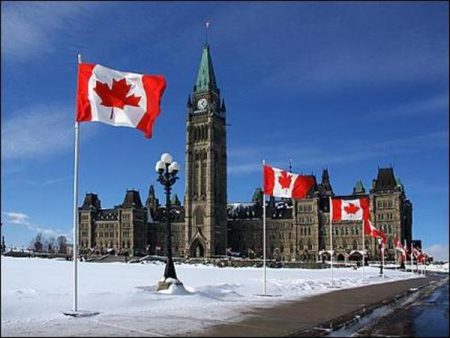The more numerous and the largest tributaries are those of the left or north bank of the St. Lawrence, draining a wide area of the Laurentian Plateau. No less than 17 rivers exceed 100 miles in length, the longest being the Ottawa River (685 miles), a large section of which forms the boundary between Ontario and Quebec.
One trait is common to all; the drainage is hesitant at the source but the flow of water becomes swifter and swifter as their courses cross the edge of the Plateau in the Laurentian hills. These are all rejuvenated rivers, developing new valley profiles amongst glacial deposits, and supplying abundant water power.
A few of these rivers will be described in detail.
The Ottawa River
Its source is to be found nearly 1,200 feet above the sea level, back of Lake Barrière dam located at Longitude 76° 45′ W. and Latitude 47° 30′ N. The river flows southwestward to Lake Timiskaming (588 feet) and then southeastward to lake TwoMountains (70 feet)where it empties into the St. Lawrence. At Grenville, half-way between Ottawa and Montreal, the Ottawa becomes the second most powerful river of Quebec; the mean annual flow is 67,330 c.f.s., the highest water being 145, 150 c.f.s, in May, the lowest, 42,640 c.f.s in September.
Besides many unused tributaries like duMoine River, the Ottawa has three tributaries along which settlement and industry are flourishing: the Gatineau, whose head is impounded back of Mercier dam on Lake Baskatong (600 feet above sea level), has a flow at Paugan Falls (halfway between Maniwaki and Hull) of 12,200 c.f.s, annually (varying from 19,100 in May to 10,000 in September); the Lièvre River, beginning away north of MontLaurier, has about half as much water as the Gatineau; the North River, draining the Central Laurentians northwest of Montreal.
The Ottawa River empties into the St. Lawrence around Montreal and Jesus Islands by three channels: to the south by the way of Lake St. Louis and the main channel of the St. Lawrence, to the northwest by the Prairie or Back River, which divides Montreal and Jesus Islands, and by the Mille-Isle River, separating Jesus Island from the mainland. They are two mighty streams; the first one having a mean annual flow of 37,400 c.f.s. (69,800 in May and 25,100 in February), the second, a mean annual flow of 7,000 c.f.s.
The St. Maurice River
The next important tributary on the same bank is the St. Maurice River. In its 300 mile course from the summit of the Laurentian Upland, the river drops from an elevation of 1,325 feet at its source in the Gouin Reservoir to sea level at Three Rivers. At Grand’Mère, 20 miles upstream, the rate of discharge varies from 72,000 c.f.s, in May to 13,400 c.f.s, in February, the annual mean being 25,000 c.f.s. Its main tributaries, the Manuan and Mattawin, are also regulated by dams at their head waters.
The Saguenay River
The most important tributary, next to the Ottawa River, is the Saguenay. It is a short river, 100 miles long, from Lake St. John (322 feet above sea level) to the Estuary. Lake St. John is fed by many streams, the most powerful of which are (clockwise on the map) Ashuapmuchuan River, Mistassini River, Mistassibi River and Peribonka River. Reservoirs are being established on the latter. The Kenogami and Shipsaw rivers are also tributary to the Saguenay. Measured at its very source, at Isle Maligne, the Saguenay has a mean annual rate of discharge of 52,600 c.f.s. (117,200 in May and 22,100 in February and March).
That whole amount of water falls to the sea level in the first 30 miles of its course. That explains why industry based on water power is so important there. Another asset of the Saguenay River is the fjord.like stretch between Chicoutimi, Haha Bay and Tadoussac. The splendour of that part culminates in front of Trinity and Eternity capes, where steep cliffs on the southern side of the fjord reach over 1,000 feet above the water.
The North Shore of the Estuary and the Gulf has also a great many tributaries that are not used except for logging purposes: Bersimis River, 249 miles long. Outarde River at Baie Comeau, 240 miles long, flowing 33,860 c.f.s, in May and 4,000 in February, Manikuagan River, 310 miles long, Ste. Marguerite River at Clark City, 130 miles long, Moisie River, 210 miles long, Romaine River, 270 miles long, and Natashkuan River, 220 miles long.
Tributaries of the right or south bank of the St. Lawrence are shorter and less powerful. They are located nevertheless in much more settled regions and a few ought to be mentioned. The Richelieu River, drains Lake Champlain (95 feet above sea level), into the St. Lawrence at Sorel. It is 70 miles long. Besides being used for navigation, it has the greatest volume among the tributaries of the South bank: 25,810 c.f.s, in May, 5,331 c.f.s, in September, and a mean annual flow of 11,870 c.f.s.
The two main rivers of the Eastern Townships are the St. Francois and Chaudière Rivers. The first one (165 miles long) has its source in the lake of the same name (951 feet above sea level) and flows southwest to Sherbrooke and thence northwest to Drummondville and Lake St. Peter. At Drummondville the rate of discharge is 6,950 c.f.s, annually (22,880 c.f.s, in April, 2,980 c.f.s, in August). The Chaudière River, 120 miles long, heads in Lake Megantic (1,294 feet above sea level), close to the United States border, and flows through Beauce County, where its spring ltoods are to be feared. At Ste. Marie, for instance, low water in February has only a flow of 1,065 c.f.s, while high water has a flow of 13,380 c.f.s, in April; and these are averages for a 25 year period. The bad spring flood of 1934, showed a catastrophic range from 587 c.f.s, in February to 22,700 c.f.s, in April.
Views: 235



